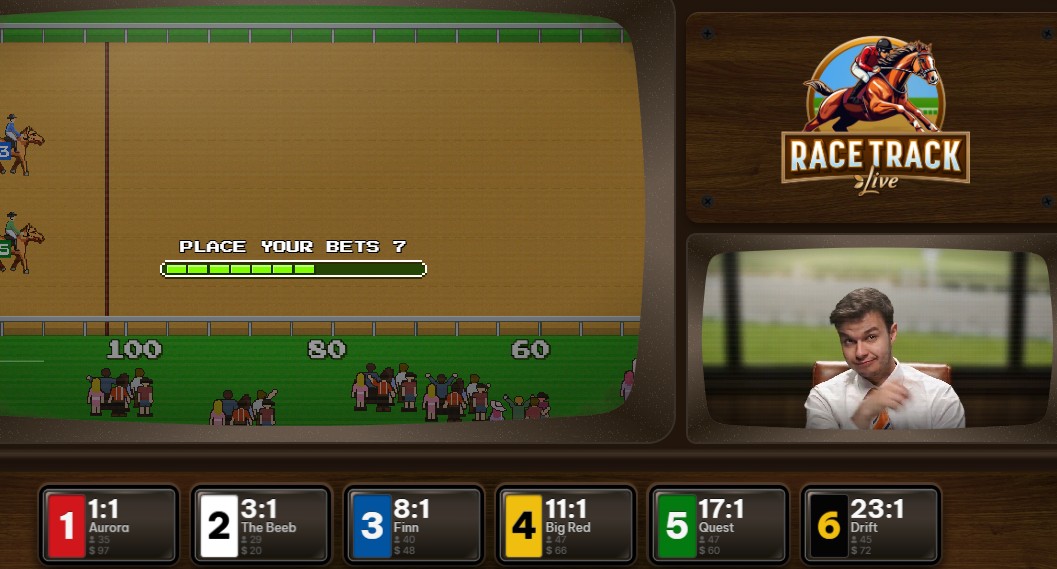Race Track by Evolution Gaming offers a fast-paced, engaging experience for players who enjoy the excitement of betting and racing. With quick rounds and simple mechanics, the game challenges you to select the horse you believe will cross the finish line first. Players can bet on one or multiple horses, with a range of odds that reflect each horse’s chance of winning. Whether you prefer to play it safe with favorites or take a risk with underdogs for higher payouts, Race Track provides an opportunity for both casual enjoyment and high-stakes betting. In this guide, we’ll walk you through the game’s rules, mechanics, and strategies to help you get the most out of every race.
Game Objective
The primary goal of Race Track is to predict which of the six horses in each race will be the winner. Players place bets on the horse they believe will cross the finish line first, and the winner is randomly determined based on its assigned odds and historical performance.
Race Structure
Each race features six horses selected randomly from a pool of 50. The horses are assigned to lanes in descending order of strength, with the strongest horse occupying lane one and the weakest in lane six. This setup gives players the opportunity to choose their bets based on the horse’s chance of winning, from more likely winners to higher-risk underdogs with larger payouts.
Betting Strategy
Players can choose to bet on one or multiple horses in each race. Betting on all six horses is allowed, which may appeal to those who want to maximize their chances of securing a win. Depending on your risk preference, you can opt for safer bets on stronger horses or take a chance on horses with higher odds for a bigger payout.
Game Mechanics
Race Track has simple mechanics that make it easy to jump into the action. Here's a breakdown of how the game works:
Horse Selection and Race Setup
- Horse Pool: There are 50 horses in total, but only six are randomly chosen to participate in each race.
- Lane Assignment: Horses are assigned to lanes based on their strength, with lane one occupied by the strongest horse and lane six by the weakest. This lane order is a key factor in determining the odds for each horse.
Betting Phase
- Players can place bets on any number of horses before the race begins. The game allows for flexibility, so you can bet on one, multiple, or all six horses.
- During the Betting Phase, you can switch between the All Horses mode and Tipster’s Choice mode.
- All Horses Mode: Shows how each horse has performed in the last 100 races, helping you gauge their historical strength compared to their theoretical winning probabilities.
- Tipster’s Choice Mode: Highlights the horses that have performed well recently, offering a more strategic approach for those looking for a guided decision.
The Race
Once the bets are locked in, the race begins, and the winning horse is randomly determined according to its odds and probability of winning. This is where the excitement builds as players eagerly await the outcome.
Winning and Payouts
The horse that finishes first determines the winning bet. Players who bet on the winning horse are paid out based on that horse's assigned odds, while bets placed on other horses are lost.
RTP and Payouts
The Return to Player (RTP) for Race Track is set at an optimal theoretical percentage of 96.00%. This RTP represents the average expected return to players over the long term, based on the total amount wagered across multiple rounds. It's important to note that this RTP is calculated across all possible bets, offering a balance between the various risk and reward options available in the game.
Payouts
Each horse in the race has its own payout, which is determined by the odds assigned to it. These payouts can vary significantly, with lower-odds horses offering smaller returns and higher-odds horses offering larger payouts. For example, horses with odds like Aurora (1:1) will offer a relatively smaller payout compared to long-shot horses like Blaze (83:1).
When a player bets on a horse and that horse wins, the payout is calculated based on the odds for that specific horse. If the horse wins, the player receives the corresponding payout, while all other bets are lost. Payouts are directly linked to the odds and vary from race to race.
RNG (Random Number Generator)
The results of the races, including the selection of the winning horse, are determined by a computerized Random Number Generator (RNG). The RNG ensures that each race outcome is completely random and unbiased, providing a fair and unpredictable gaming experience.
Betting Limits
Race Track offers flexible betting options with a wide range of limits that cater to both casual and high-stakes players. The minimum and maximum bet limits are displayed in the Bet Limits panel and may vary depending on the specific table or session.
Current Bet Limits
- Minimum Bet: $0.10 per race
- Maximum Bet: $5,000 per race
These limits ensure that players can enjoy a variety of betting styles, from small wagers to larger, more competitive stakes. The available bet limits can change, so it's important to check the Bet Limits panel for the most accurate and up-to-date information before placing your bets.
Betting Distribution Strategies for Race Track
In Race Track, betting strategies can be tailored based on your risk tolerance. Whether you prefer to play it safe, take moderate risks for more excitement, or go all-in for big payouts, here's a breakdown of three possible betting strategies.
Low-Risk Betting Strategy
For players who prefer to minimize risk and focus on consistent, smaller returns, the low-risk strategy aims to bet on horses with higher chances of winning. These horses typically have lower odds but offer a more predictable outcome.
Betting Distribution:
- Bet on the Strongest Horses: Focus primarily on horses with the lowest odds (e.g., 1:1 to 3:1).
- Example Distribution:
- 2 bets on horses with 1:1 odds (e.g., Aurora, Moon)
- 1 bet on a horse with 2:1 odds (e.g., Odd or Honey)
In this approach, you place most of your bets on horses with a higher chance of winning, while still including a safer bet with slightly higher odds. The goal is to secure smaller, more frequent wins rather than chasing big payouts.
Medium-Risk Betting Strategy
A medium-risk strategy provides a balance between safety and excitement. Players look to diversify their bets by combining a mix of lower and mid-range odds, giving them both stable returns and the possibility of larger wins.
Betting Distribution:
- Bet on a Combination of Strong and Average Horses: Include bets on horses with odds from 1:1 to 8:1.
- Example Distribution:
- 1 bet on a horse with 1:1 odds (e.g., Aurora or Odd)
- 1 bet on a horse with 3:1 odds (e.g., Lightning)
- 1 bet on a horse with 8:1 odds (e.g., Finn or Time)
This strategy balances safer bets with horses that offer a higher payout, increasing your chances of larger wins while still maintaining relatively low risk.
High-Risk Betting Strategy
For players who are willing to take bigger risks for the chance of higher payouts, the high-risk strategy focuses on underdogs and horses with longer odds. While these horses are less likely to win, the potential rewards are much larger.
Betting Distribution:
- Bet on Underdogs with High Odds: Focus primarily on horses with odds of 11:1 and above.
- Example Distribution:
- 1 bet on a horse with 11:1 odds (e.g., Big Red or Lil Blue)
- 1 bet on a horse with 23:1 odds (e.g., Drift)
- 1 bet on a horse with 83:1 odds (e.g., Blaze)
This strategy is for those who want to play for big wins and are comfortable with the possibility of losing all their bets. By focusing on the higher-odds horses, you're gambling for larger rewards, with the understanding that your chances of winning are smaller.

